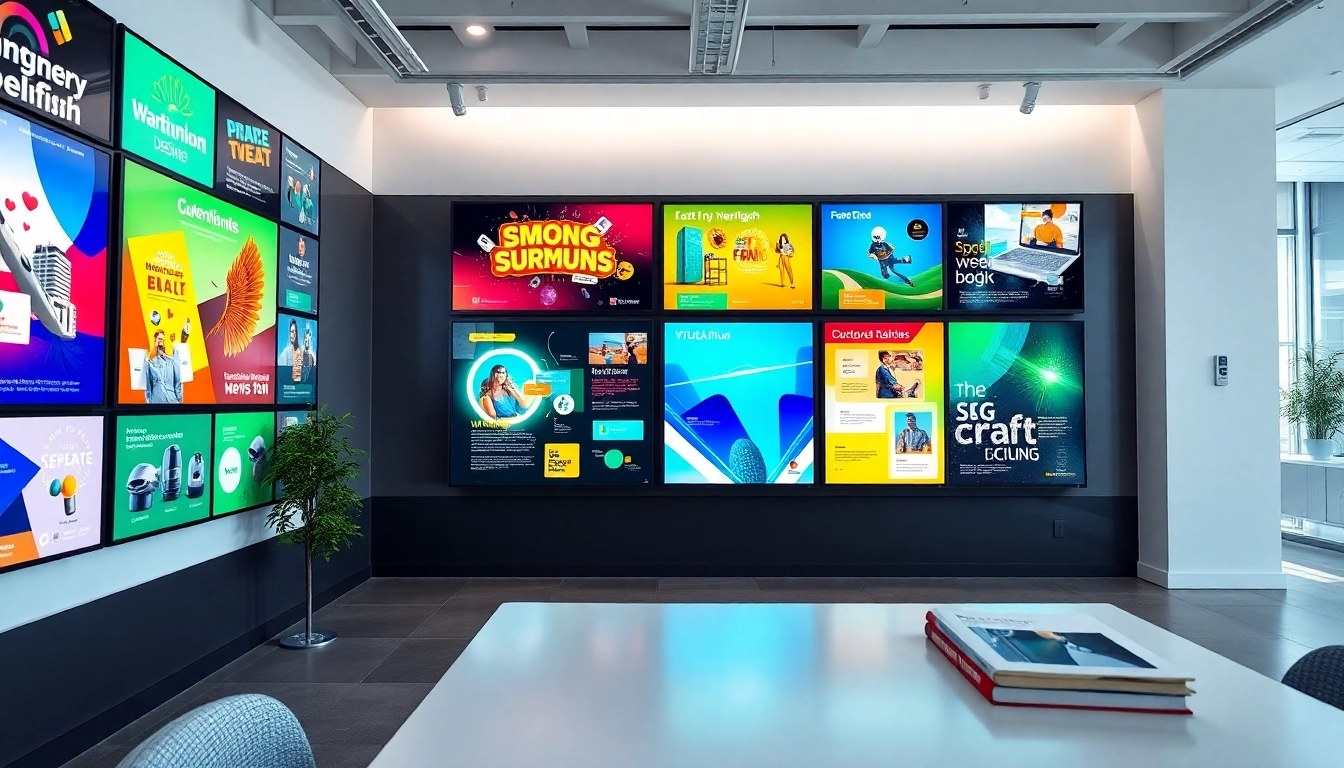Understanding Digital Signage and Its Importance
Introduction to Digital Signage
Digital signage refers to the use of digital displays to communicate information, advertise products and services, or provide entertainment to audiences. This technology plays a pivotal role in how businesses engage their customers, as it replaces traditional static signage with dynamic visual content. Digital signage can range from simple screen displays in retail outlets to complex networks of video walls in corporate environments. As organizations seek innovative ways to connect with their audiences, understanding the implications and functionalities of digital signage becomes essential for effective communication strategies.
Benefits of Using Digital Signage
The benefits of adopting digital signage are extensive. Firstly, it enhances visibility. Digital displays draw attention more effectively than static signs, thanks to eye-catching animations and vivid colors. This increased attention translates to improved customer engagement and brand awareness.
Secondly, digital signage offers flexibility. Content can be updated remotely and instantly, allowing organizations to respond to market trends, special promotions, or even emergencies without incurring additional costs for reprinting materials. This capability not only saves time but also ensures that the information presented is relevant and timely.
Moreover, digital signage can improve operational efficiency. By automating content updates and displaying pertinent information in real time, businesses can streamline communications within their teams and towards their customers. For instance, wayfinding and event scheduling can be showcased dynamically, enhancing the customer experience.
Lastly, the integrated analytics provided by many digital signage platforms allow organizations to gauge their signage’s effectiveness through user interaction metrics. This data can be leveraged to refine marketing strategies, thus maximizing return on investment.
Common Applications in Various Industries
Digital signage finds its utility across various sectors, adapting to meet unique communication needs. In the retail industry, for example, signage can be used to highlight special sales, showcase new products, or offer promotional discounts. Interactive displays can further enhance customer experience by providing detailed product information or engaging customers through gamified sales processes.
The healthcare sector also benefits significantly from digital signage. Hospitals and clinics utilize it to display important announcements, wayfinding information, and health tips for patients and visitors, creating a more streamlined experience in high-traffic areas.
In the educational sector, schools and universities leverage digital signage for communication among students, faculty, and staff. News updates, event announcements, and emergency notifications can be broadcasted effectively, reaching wide audiences.
Moreover, corporate environments employ digital signage for internal communication, employee engagement, and branding. Screens displaying company values, performance metrics, and upcoming events can help foster a cohesive organizational culture.
Exploring Canva Alternative for Signage Solutions
Key Features to Look For
When considering alternatives to Canva for creating signage, it’s important to evaluate specific features that enhance usability and design capability. Look for user-friendly interfaces that allow easy drag-and-drop functionality, catering to both novices and professionals. The availability of customizable templates tailored to different signage formats and styles is also crucial.
Another significant feature is integration capabilities with other marketing tools and platforms. A robust alternative should enable seamless transitions between different design formats and facilitate collaboration among team members. Additionally, ensuring high-quality export options and compatibility with various display hardware can streamline your signage deployment process.
Comparative Analysis of Design Tools
While Canva is widely recognized, there are several contenders in the market that offer compelling features suitable for signage creation. Tools like Adobe Spark, Visme, and Snappa provide varying functionalities aimed at fulfilling different design needs. For instance, Adobe Spark excels in allowing users to create stunning graphics with its extensive library of images and design assets, providing more advanced editing options compared to Canva.
Visme distinguishes itself by offering comprehensive tools suited for data visualization and interactivity, while Snappa is tailored for quick and straightforward design processes, making it ideal for those who prioritize speed. Evaluating these alternatives based on specific project needs, user experience, and pricing structures is essential in selecting the right platform.
User Experiences and Feedback
User feedback often highlights key areas that distinguish various design tools in their approach to signage solutions. Positive reviews for platforms like Adobe Spark and Visme frequently revolve around their sophisticated design options and user support. For example, users appreciate Adobe Spark for its styling features that allow for extensive personalization in designs.
Conversely, issues such as limitations in free plans and occasional complexity in navigating advanced functions can lead to frustration if not addressed adequately. Hence, a comprehensive understanding of user experiences will aid prospective users in making informed decisions about which Canva alternative for signage aligns best with their creative goals.
Steps to Create Stunning Signage
Choosing the Right Tool for Your Needs
Identifying the appropriate design tool is a critical first step in the signage creation process. Start by assessing your specific requirements; consider factors like budget, project scope, desired functionalities, and user experience. For example, if you need interactive signage, you may prioritize tools that specialize in multimedia capabilities over simpler, template-based platforms.
Consulting user reviews and conducting trial versions of different design software can also provide valuable insight into what may work best for your projects. Canva alternative for signage should embody characteristics tailored to facilitate your design workflow, ensuring a pleasant user experience along with robust outputs.
Designing Eye-Catching Graphics
Once you’ve selected a tool, concentrate on designing graphics that captivate and engage your audience. Begin with a solid concept and clear messaging that resonates with your target audience. Incorporate brand colors and logos for consistency, and choose typography that is readable from a distance and visually appealing.
Utilize white space strategically to draw attention to important information and reduce clutter, while integrating images or icons that support your message. The right mix of visuals can create memorable signage that leaves a lasting impression. Experimentation with layout and design elements can yield innovative results, setting your signage apart from competitors.
Implementing and Displaying Your Signage
After finalizing your design, the next phase is effective implementation. Assess the best physical or digital venues for your signage, factoring in visibility and foot traffic in physical locations or high engagement when showcased digitally. Ensure the equipment or materials used for displaying your signage align with the quality of your designs.
In digital signage, compatibility with display technology is paramount. Whether using digital screens, LED walls, or projection, select the appropriate resolution and format that showcases your graphics most effectively. Regularly update your content to maintain relevance and maximize audience engagement through strategic content scheduling and rotation.
Case Studies of Successful Signage Implementations
Real-World Examples of Effective Signage
Numerous organizations have harnessed the power of digital signage to transform their customer engagement strategies. One notable example includes a retail chain that integrated interactive touchscreen displays in their store layout, allowing customers to explore product details, reviews, and promotions. This initiative led to a measurable increase in in-store sales and customer satisfaction.
Similarly, educational institutions implementing digital boards to streamline communication on campus have reported improved student engagement. By broadcasting event schedules, important announcements, and student achievements, these institutions created a more informed and connected campus environment.
Lessons Learned from Signage Projects
Each implementation of digital signage comes with unique lessons. Organizations have learned the importance of aligning digital content closely with audience interests and behaviors. Understanding the target demographic helps tailor visuals and messages, ultimately increasing effectiveness.
Moreover, maintaining consistency in branding across all signage has proven vital for recognition and trust. Ensuring that all digital assets complement one another holistically can enhance brand perception and the overall user experience.
Improvements and Iterations Over Time
The digital signage landscape is dynamic; as technology advances, so do design strategies and user preferences. Iterative improvements based on analytics and user feedback are essential for successful long-term signage management. An organization’s ability to pivot, test new design formats, and integrate emerging trends will dictate its effectiveness in engaging audiences over time.
Measuring the Impact of Your Signage
Key Performance Indicators to Consider
Establishing measurable goals is critical in evaluating the impact of your signage initiatives. Key performance indicators (KPIs) may include metrics such as engagement rates, audience dwell time, conversion rates, and overall sales performance linked to specific signage campaigns. By tracking these KPIs, organizations can gauge the effectiveness of their signage and make data-driven decisions regarding future content and strategies.
Tools for Analyzing Signage Effectiveness
Employing analytics tools can significantly enhance your ability to measure signage impact. Many digital signage platforms come equipped with built-in analytics that track user interactions and performance metrics. Additionally, third-party analytics tools may provide deeper insights into customer behavior and preferences, empowering businesses to refine their messaging strategies further.
Next Steps for Continuous Improvement
Continuous improvement should be a fundamental goal for any signage strategy. Regularly revisiting and analyzing KPIs will enable organizations to identify underperforming areas and pivot accordingly. Involving stakeholders, including marketing teams and design professionals, can foster the exchange of ideas and best practices, leading to more innovative signage solutions. Iterative design testing and audience engagement surveys can also provide valuable feedback, ensuring that the signage remains relevant and effective over time.



